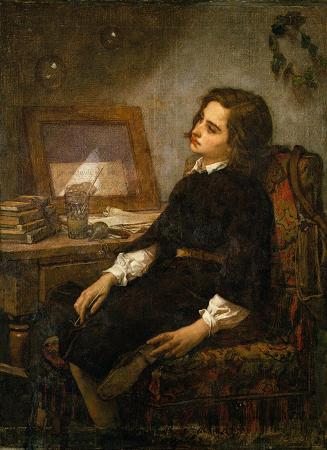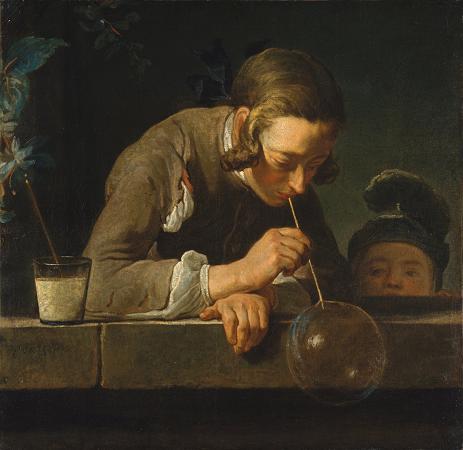Soap Bubbles. A soap bubble is an extremely thin film of soapy water enclosing air that forms a hollow sphere with an iridescent surface. Soap bubbles usually last for only a few seconds before bursting, either on their own or on contact with another object. They are often used for children's enjoyment, but they are also used in artistic performances. Assembling several bubbles results in foam. When light shines onto a bubble it appears to change colour. Unlike those seen in a rainbow, which arise from differential refraction, the colours seen in a soap bubble arise from interference of light reflecting off the front and back surfaces of the thin soap film. Depending on the thickness of the film, different colours interfere constructively and destructively. Seman bubbles. Soap bubbles are physical examples of the complex mathematical problem of minimal surface. They will assume the shape of least surface area possible containing a given volume. A true minimal surface is more properly illustrated by a soap film, which has equal pressure on inside as outside, hence is a surface with zero mean curvature. A soap bubble is a closed soap film: due to the difference in outside and inside pressure, it is a surface of constant mean curvature. While it has been known since 1884 that a spherical soap bubble is the least-area way of enclosing a given volume of air, it was not until 2000 that it was proven that two merged soap bubbles provide the optimum way of enclosing two given volumes of air of different size with the least surface area. This has been dubbed the double bubble conjecture. Because of these qualities, soap bubbles films have been used with practical problem solving application. Structural engineer Frei Otto used soap bubble films to determine the geometry of a sheet of least surface area that spreads between several points, and translated this geometry into revolutionary tensile roof structures. A famous example is his West German Pavilion at Expo 67 in Montreal. When two bubbles merge, they adopt a shape which makes the sum of their surface areas as small as possible, compatible with the volume of air each bubble encloses. If the bubbles are of equal size, their common wall is flat. If they aren't the same size, their common wall bulges into the larger bubble, since the smaller one has a higher internal pressure than the larger one, as predicted by the Young-Laplace equation. At a point where three or more bubbles meet, they sort themselves out so that only three bubble walls meet along a line. Since the surface tension is the same in each of the three surfaces, the three angles between them must be equal to 120°. Only four bubble walls can meet at a point, with the lines where triplets of bubble walls meet separated by cos −1 ≈ 109.47°. All these rules, known as Plateau's laws, determine how a foam is built from bubbles. The longevity of a soap bubble is limited by the ease of rupture of the very thin layer of water which constitutes its surface, namely a micrometer-thick soap film.It is thus sensitive to: Drainage within the soap film: water falls down due to gravity. This can be slowed down by increasing the water viscosity, for instance by adding glycerol. Still, there is an ultimate height limit, which is the capillary length, very high for soap bubbles: around 13 feet. In principle, there is no limit in the length it can reach. Evaporation: This can be slowed down by blowing bubbles in a wet atmosphere, or by adding some sugar to the water. Dirt and fat: When the bubble touches the ground, a wall, or our skin, it usually ruptures the soap film. This can be prevented by wetting these surfaces with water. When a soap bubble is in contact with a solid or a liquid surface wetting is observed. On a solid surface, the contact angle of the bubble depends on the surface energy of the solid., A soap bubble has a larger contact angle on a solid surface displaying ultrahydrophobicity than on a hydrophilic surface-see Wetting. On a liquid surface, the contact angle of the soap bubble depends on its size-smaller bubbles have lower contact angles. The composition of soap bubbles' liquid has many recipes with slightly different ingredients. The most common one contains: 2/3 cup of dishwashing soap. 1 gallon of water. 2/3 tablespoon of glycerine. Because of the presence of dishwasher soap, it's not uncommon for children to contract dermatitis on face, hands with consequences as rashes, swelling of the eyes, vomiting and dizziness. See also Unconventional computing. The structures that soap films make can not just be enclosed as spheres, but virtually any shape, for example in wire frames.
more...








